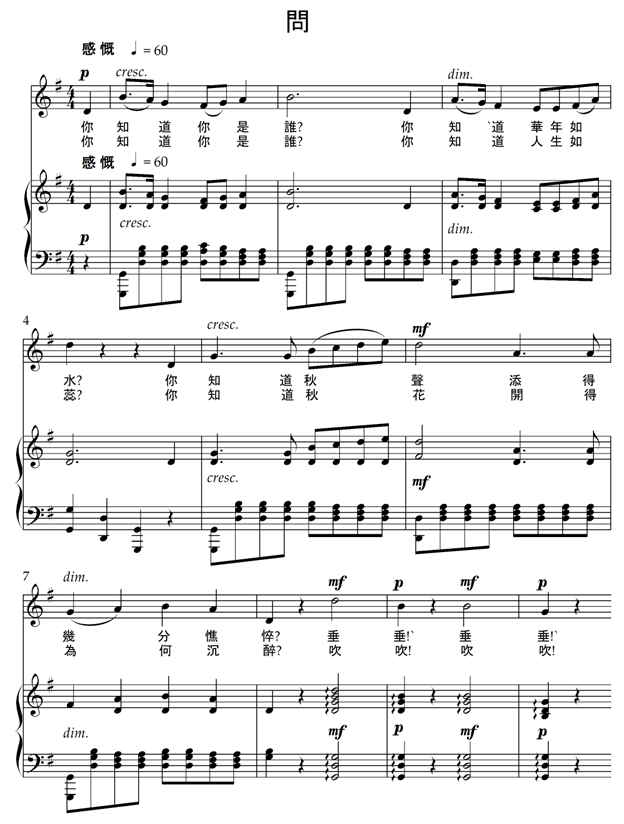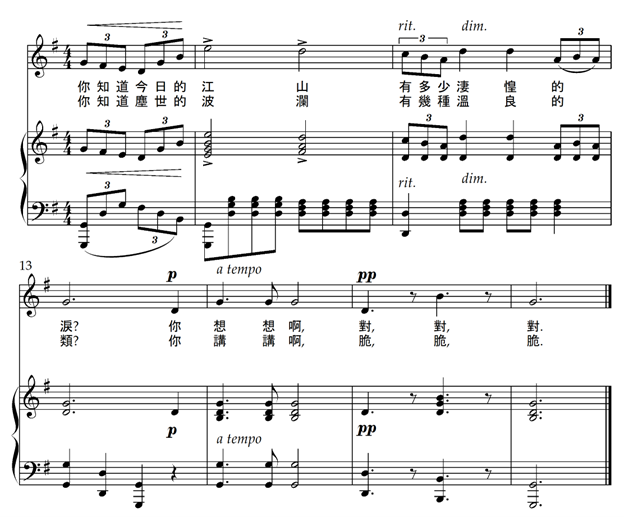__Xinshi geji 新詩歌集
Four years after the publication of Xinyue chuji 《新樂初集》, Zhao Yuanren 趙元任 (1892-1982) brought forward his song collection Xinshi geji 新詩歌集 [Songs of contemporary poems].[1] Except for the first half of the song “Ping hua 瓶花” [Flowers in the Jar][2], all the lyrics in the collection were written in plain language by contemporary authors, including “Autumn Bell 秋鐘,” a poem by the composer himself. The words of “Drinking song” (No. 12) was translated from The Lady of the Camellias by Liu Bannong.[3]
Right from the beginning of the introduction, Zhao clearly indicated that the works in the selection modeled after the art song style of Schubert and Schumann.[4] Twelve of the fourteen songs are for solo voice and piano. “Workmen’s Song 勞動歌” (No. 8) could be sung by one singer but would be more effective and exciting as an ensemble piece. “Sea Rhyme 海韻” (No. 14), written for a mixed voice choir with a soprano solo, could be treated as a solo song without the chorus.
Several songs in the collection have become part of the standard Chinese art song repertoire. Among them, “Jiao wo ruhe buxiang ta 教我如何不想她” [How Can I Help but Think of Her?][5] set to the words of Liu Bannong was the most popular work, beloved by musicians and audience alike.
__Zhao Yuanren and Liu Bannong 趙元任和劉半農
Liu Bannong 劉半農 (1891-1934), a.k.a. Liu Fu 劉復[6], was a pioneer of literary reform and a frequent contributor to the New Youth magazine.[7] Before making Liu’s acquaintance, Zhao Yuanren recognized the linguistic fluidity in his new style poetry. After the publication of Liu’s Sisheng shiyan lu《四聲實驗錄》 [Records of Experiments on the Four Tones] in 1924,[8] Zhao realized Liu was also a serious linguist.
In 1924, during his research tour in Europe, Zhao visited Liu, who was completing his Ph.D. studies in Paris. Both passionate in linguistic/phonetic studies and music,[9] they struck up a friendship immediately. Zhao accepted a teaching position at Tsinghua University in 1925. Liu also returned to China in August of the same year and began teaching at Beijing University and l’Université Franco-Chinoise 中法大學.
They formed an informal society “Suren hui 數人會”—literally, “a few people’s group”—with Qian Xuantong 錢玄同, Li Jinxi 黎錦熙, Lin Yutang 林語堂 and Wang Yi 汪怡, all reform-minded linguists/phonologists.[10] Between September 1925 and September 1926, they held twenty-two meetings at Zhao’s house, developing a Romanized spelling system of Chinese language. The result of their study was known as “Gwoyeu Romatzyh 國語羅馬字,” briefly adopted by the Nationalist government but eventually replaced by Pinyin.[11]
While highly intelligent, Zhao and Liu both possessed a sense of humor—self-deprecating at times. More than a professional bond, their kinship was a personal one and lasted until Liu’s untimely death in 1934. The songs that they co-wrote were testimonies of their creative minds.
__ “Jiao wo ruhe buxiang ta 教我如何不想她”
The poem was written on September 4, 1920, in London. Originally entitled “Qing ge 情歌” [Love song], the new title 教我如何不想她 first appeared in Liu’s poetic collection Yang-bian ji 揚鞭集 (1926).[12] Prior to this poem, the third person singular pronoun “他 ta” in Chinese language was gender neutral. Liu used the character “她” with a radicle “女 nü,” indicating the feminine gender of the subject. It was widely believed that the poet used it as a metaphor of the “mother land,” and the poem was a love song to the country. In an interview conducted by Rosmary Levenson in 1970s, Zhoa indicated that the subject should be gender neutral and without specific associations.[13] Interestingly, in Xinshi geji, he used “他” as the title for his setting of a short poem by Hu Shi 胡適. Yet he translated it as “She” for the English song list and noted: (i.e. China).
Since the text, translation, and structure of the poem has been discussed in an earlier post, only the pronunciation guide will be provided here: [14]
天上飄著些微雲,
[tian1 shang4 piao1 zhe5 xie1 wei2 yun2]
ㄊㄧㄢˉ ㄕㄤˋ ㄆㄧㄠˉ ㄓㄜ˙ ㄒㄧㄝˉ ㄨㄟˊ ㄩㄣˊ
地上吹著些微風。
[di4 shang4 chui1 zhe5 xie1 wei2 feng1]
ㄉㄧˋ ㄕㄤˋ ㄔㄨㄟˉ ㄓㄜ˙ ㄒㄧㄝˉ ㄨㄟˊ ㄈㄥˉ
啊! 微風吹動了我頭髮,[15]
[a1 wei2 feng1 chui1 dong4 liao3 wo3 to2 fa3]
ㄚˉ ㄨㄟˊ ㄈㄥˉ ㄔㄨㄟˉ ㄉㄨㄥˋ ㄌㄧㄠˇ ㄨㄛˇ ㄊㄡˊ ㄈㄚˇ
教我如何不想她?
[jiao4 wo3 ru2 he2 bu4 xiang3 ta1]
ㄐㄧㄠˋ ㄨㄛˇ ㄖㄨˊ ㄏㄜˊ ㄅㄨˋ ㄒㄧㄤˇ ㄊㄚˉ
******************************
月光戀愛著海洋,
[yue4 guang1 lian4 ai4 zhe5 hai3 yang2]
ㄩㄝˋ ㄍㄨㄤˉ ㄌㄧㄢˋ ㄞˋ ㄓㄜ˙ ㄏㄞˇ ㄧㄤˊ
海洋戀愛著月光。
[hai3 yang2 lian4 ai4 zhe5 yue4 guang1]
ㄏㄞˇ ㄧㄤˊ ㄌㄧㄢˋ ㄞˋ ㄓㄜ˙ ㄩㄝˋ ㄍㄨㄤˉ
啊!這般蜜也似的銀夜。
[a1 zhe4 ban1 mi4 ye3 si4 di1 yin2 ye4]
ㄚˉ ㄓㄜˋ ㄅㄢˉ ㄇㄧˋ ㄧㄝˇ ㄙˋ ㄉㄧ˙ ㄧㄣˊ ㄧㄝˋ
教我如何不想她?
[jiao4 wo3 ru2 he2 bu4 xiang3 ta1]
ㄐㄧㄠˋ ㄨㄛˇ ㄖㄨˊ ㄏㄜˊ ㄅㄨˋ ㄒㄧㄤˇ ㄊㄚˉ
******************************
水面落花慢慢流,
[shui3 mian4 luo4 hua1 man4 man4 liu2]
ㄕㄨㄟˇ ㄇㄧㄢˋㄌㄨㄛˋ ㄏㄨㄚˉ ㄇㄢˋ ㄇㄢˋ ㄌㄧㄡˊ
水底鱼兒慢慢游。
[shui3 di3 yü2 er5 man4 man5 you2]
ㄕㄨㄟˇ ㄉㄧˇ ㄩˊ ㄦ˙ ㄇㄢˋ ㄇㄢ˙ ㄧㄡˊ
啊! 燕子你說些什麽話?
[a1 yan4 zi5 ni3 shuo1 xie1 she2 me5 hua4]
ㄚˉ ㄧㄢˋ ㄗ˙ ㄋㄧˇ ㄕㄨㄛˉ ㄒㄧㄝˉ ㄕㄜˊ ㄇㄜ˙ ㄏㄨㄚˋ
教我如何不想她?
[jiao4 wo3 ru2 he2 bu4 xiang3 ta1]
ㄐㄧㄠˋ ㄨㄛˇ ㄖㄨˊ ㄏㄜˊ ㄅㄨˋ ㄒㄧㄤˇ ㄊㄚˉ
******************************
枯樹在冷風裏搖,
[ku1 shu4 zai4 leng3 feng1 li yao2]
ㄎㄨˉ ㄕㄨˋ ㄗㄞˋ ㄌㄥˇ ㄈㄥˉ ㄌㄧˇ ㄧㄠˊ
野火在暮色中燒。
[ye3 huo3 zai4 mu4 se4 zhong1 shao1]
ㄧㄝˇ ㄏㄨㄛˇ ㄗㄞˋ ㄇㄨˋ ㄙㄜˋ ㄓㄨㄥˉ ㄕㄠˉ
啊! 西天還有些兒殘霞,
[a1 xi1 tian1 hai2 you3 xie1 er5 can2 xia2]
ㄚˉ ㄒㄧˉ ㄊㄧㄢˉ ㄏㄞˊ ㄧㄡˇ ㄒㄧㄝˉ ㄦ˙ ㄘㄢˊ ㄒㄧㄚˊ
教我如何不想她?
[jiao4 wo3 ru2 he2 bu4 xiang3 ta1]
ㄐㄧㄠˋ ㄨㄛˇ ㄖㄨˊ ㄏㄜˊ ㄅㄨˋ ㄒㄧㄤˇ ㄊㄚˉ
The above transliteration is largely based on Zhao Yuanren’s own interpretation in a Pathé-Columbia Recording.[16] Details of a few words/characters should not be overlooked:
- The literary pronunciations are used for the adverb 了 [liao3/ㄌㄧㄠˇ] in stanza 1, verse 3 and the particle 的 [di1/ㄉㄧˉ], stanza 2, verse 3.
- The reiterative locution 慢慢 (slowly, slowly) in stanza 3 is treated differently in verses 1 and 2. In the first verse, it is sung with consecutive fourth tone [man4 man4/ㄇㄢˋ ㄇㄢˋ] accompanied by legato melodic line. In the second verse, the words are set to a dotted-note pattern with a short ending. Thus, the neutral (light) tone should be applied to the second character.
- The兒 in the two erhua word-groups, namely 鱼兒 in stanza 3, verse 2, and 有些兒 in stanza 4, verse 3, should both be pronounced with clear [ㄦ/er] sound but lighter than the regular second tone.
- In the appended section of Xinshi geji, Zhao discussed various pronunciations of the character還 which appeared in stanza 4, verse 3. Finding the literary pronunciation [ㄏㄨㄢˊ/huan2] too artificial, he suggested a modified sound [ㄏㄢˊ/han2] for lyrics in the collection. The latter is hardly heard today. To fit the vernacular characteristics of the poem, the colloquial pronunciation [ㄏㄞˊ/hai2] is applied here. [17]
__The Song
Structurally, Zhao’s musical setting corresponds to the poetic construct—sectional with repeated texts set to slightly varied refrains. In the opening phrases, a pedal tone on E3 in the piano part (mm. 1-12) firmly established the tonal center for the entire piece. While using the standard harmonic progressions in the accompaniment, Zhao achieved a Chinese-sounding melodic line by avoiding the pitches a and d-sharp, the fourth and the seventh note of the E major scale.

At the entrance of the second stanza (m. 22), the E3 pedal tone returns. The melodic line remains in the pentatonic mode as the tonality gradually shifts into the dominant B major. A four-bar instrumental extension (mm. 37-40) concludes the first half of the song.
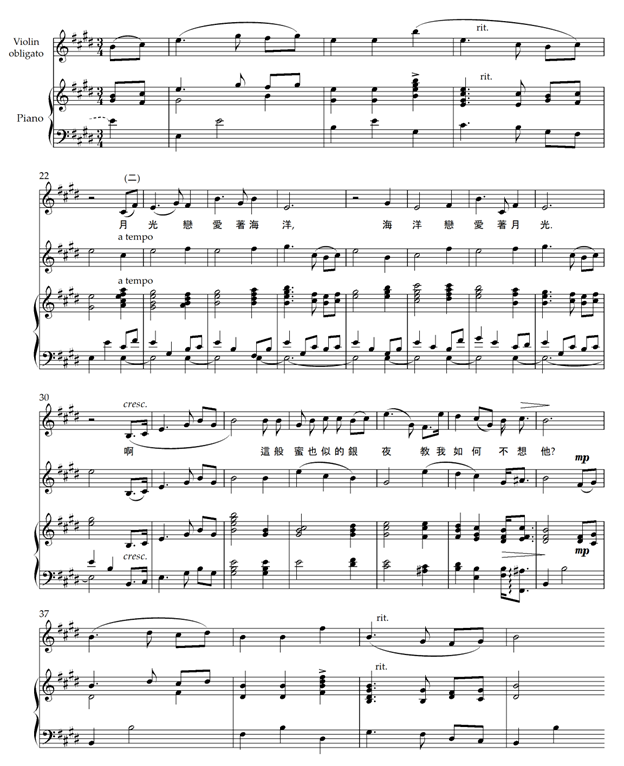
The opening introduction returns in m. 41. Although the E3 pedal tone and the E major chord progression reoccur (mm. ’40-52), the vocal lines from mm. ’44-51 is centered around c-sharp, the tonic of the relative minor key. The key signature changes to one sharp in m. 53, indicating a shift to the parallel E minor. The repeated a-sharps in the new phrases (mm. 53-55) pushes the tonality toward the dominant B minor before settling into G major, the relative key of E minor. (mm. 57-58).
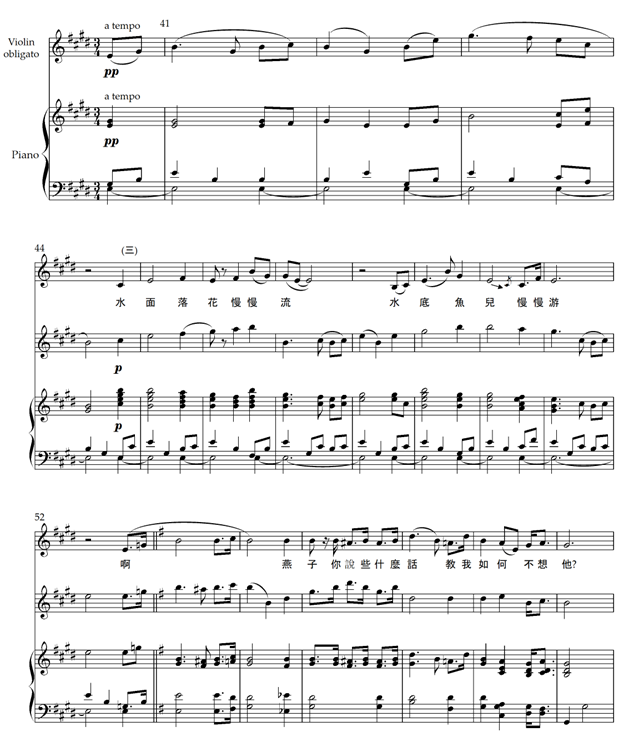
After a brief interlude (mm. ’58-62) is in G pentatonic major, the fourth—and last—stanza begins in E minor. The darker harmonic tone was enhanced by a meter change from triple to quadruple, slowing down the musical movements (mm. 62-66). As indicated in the text, the gloomy mood was not to stay: “. . . Some twilight glows are still lingering on the western sky.” The triple meter is restored. The song ends with a strong ending in E major.
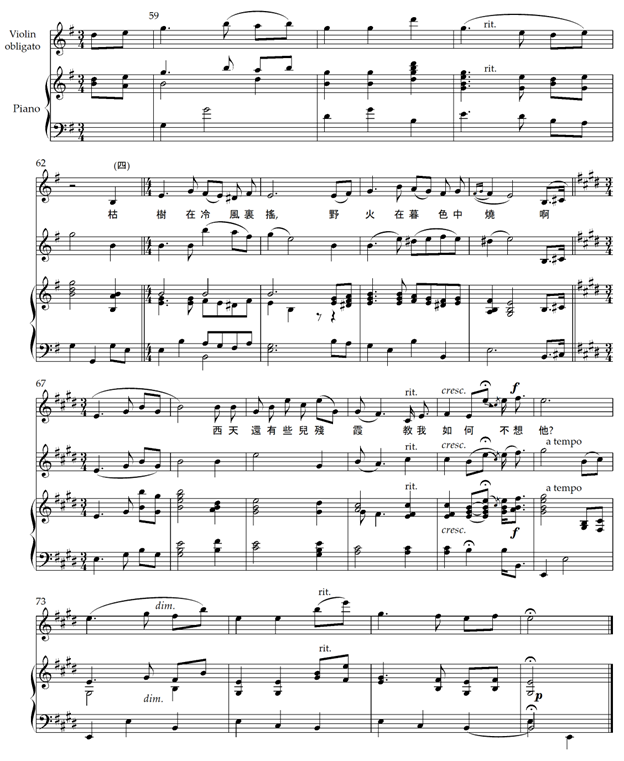
__ Xipi yuanban guomen 西皮原板過門
The composer wrote in the commentary section of the songbook that, with the exceptions of “燕子你說些什麽話?” (mm. ’54-56) and “枯樹在冷風裏搖, 野火在暮色中燒。” (mm. ’62-66), the song was characteristically Chinese.[18] In addition to balancing pentatonic melodies and western-styled harmonies, he adopted the cadential passage of xipi yuanban guomen 西皮原板過門, the instrumental interlude in Chinese opera, for the refrain –and the theme—of the song, “教我如何不想她?”
The use of preexisting melody, cantus firmus, is a common practice in western musical tradition. With Chinese (Peking) opera being a popular form of entertainment, Zhao’s choice of his basic melodic pattern was a familiar one to the readers and interpreters when the work was written. It would, nonetheless, require some explanations to today’s performers and audiences, Asian and western alike.
With a wide range of subject matters and dramatic styles, musically, the entire repertoire of Peking opera was built upon two melodic patterns, xipi 西皮 and erhuang 二黃, and their variations. The fundamental differences between them are the tuning on the jinghu 京胡,[19] a two-string bowed instrument which plays the melody heterophonically with the singer. The two strings on the jinghu are always tuned a fifth apart. For xipi, the open strings are tuned to d and a, the sixth (lower) and the third of an F scale. For erhuang, they are tuned one step lower to c and g. This results in xipi sounding brighter and vivacious, and erhuang¸ mellower and more lyrical.
Both melodic types have several different tempos and rhythmic patterns. The primary ones are called yuanban 原板, meaning “the original beat pattern.” Xipi yuanban is a two-beat pattern, alternating between ban 板, the strong beat played on a clapper called paiban 拍板,[20] and yan 眼, the weak beat played on a small drum.
Structurally, the music in Chinese opera comprises of cycles of musical phrases. Each musical section is constructed around two verses of texts with the basic form of “percussion/instrumental introduction—verse one—instrumental interlude—verse two—instrumental conclusion.” The interlude is called guomen 過門 [crossing the threshold]. Although, with improvisations from both the singers and the instrumentalists, the renditions in live performances can vary greatly, the basic melodic and rhythmic patterns in each section are predetermined. While the lead-in might vary slightly, the standard ending phrase of xipi yuanban guomen is as follows:[21] The numbers below the notes refer to scale degrees in F.

Zhao used the final notes of this melody for his refrain. Here are the cadential notes and Zhao’s application in the first stanza (mm. ’16-18):
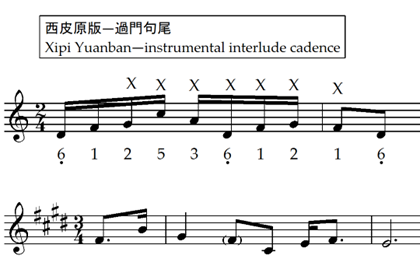
In performance practice, a second degree note (g) is often added between the a and the d in the guomen. Zhao apparently modeled after this variant. For the ending of the second stanza (mm. ’34-36), the melody is moved up to B major and the interval between the two notes was widened. The third stanza is a third higher than the first one. In the final phrase of the song, the refrain starts in the lower register and leaps up to end an octave higher than the first stanza.
__Violin obbligato
In a brief English introduction in the revised edition of Xinshi geji, Zhao wrote: “This new edition introduces some changes in the explanatory notes and the accompaniments, including the addition of a violin obbligato in Song No. 11, previously used in a Pathé-Columbia Recording No. 24828.”[22] From this statement, we learned that the violin obbligato was not included in the original version but was created before 1936.
__Interpretation
Zhao Yuanren was a true Renaissance man of many talents. His delivery of “Jiao wo ruhe buxiang ta” was not a brilliant display of vocal skills but a sincere reflection of his artistic intention. One hears frequently slight portamenti between notes. The effect is closer to Chinese folk song singing than western bel canto style vocal production.
Twice (m. 50, on 兒 and m. 71, on 何) he used a small downward arrow to indicate a slide of pitch. He then suggested in his notes that, when singing this song, it would be most important to keep it smooth and sweet. If necessary, portamenti could be applied, marked or not.
__Postlude
When Liu Bannong passed away in 1934, Zhao eulogized him with a poem:
十載湊雙簧,無詞今後難成曲;
數人弱一個,教我如何不想他。
Partnering for ten years in our shuanghuang act,
hereafter, it would be hard to create songs without verses;
“Gathering of Several” deprived of one, how can I help but think of him.
雙簧 shuanghuang is a two-man comic act in which one acts out the plot and the other provides verbal interpretations in words or in songs. The actors must have great chemistry with each other. In a few words, Zhao indicated that he not only lost a creative partner but also a confidant. He quietly addressed their collaborations on the linguistic reform. And, finally, the one song that was close to their hearts.
[1] The translation “Songs of contemporary poems” was taken from the second, revised edition (Taipei, 1960)
[2] All the English titles are taken from the list in the revised edition (Taipei, 1960). https://goldfishodyssey.com/2022/08/17/musical-settings-ii-words-tones-and-music/
[3] The first section of “Ping hua” was set to the seven-character jueju 七言絕句by Fan Chengda 范成大 (1126-1193). The words of the second section were written by Hu Shi. https://en.wikipedia.org/wiki/Fan_Chengda
In the Preface (譜頭語), Zhao indicated that, with the exceptions of “Crossing the Indian Ocean 過印度洋” by Zhou Wuruo 周無若 and “Ballad of the Cloth Vender 賣布謠” by Liu Dabai 劉大白, the poets consented to provide their words as song lyrics. Hu Shih had some reservation about his text “Ta 他” for its outward naiveté. The words of “Lao‘dong ge 勞動歌“ [Workmen’s Song] was an anonymous poem included in a collection of plain-language poetry Baihua shixuan 白話詩選, originally appeared in the journal Xingqi pinglun 星期評論 [Weekly Review].
“本集的歌詞的選擇,大部分是原著者贊成給這幾首作歌而作的,只有一首《他》胡適之先生嫌他太幼稚了,我說我做的這點音樂也幼稚,橫豎是個 scherzando 的玩意兒,就放進去讓 “他” scherzando scherzando 罷。還有《勞動歌》是在《白話詩選》裡看見的,上頭載的是見《星期評論》,但是我查了好久也沒有查出原著者是哪一位,所以沒有機會跟原著者商量。還有寫《過印度洋》的周無若先生跟寫《賣布謠》的劉大白先生我也沒有找到通信的路徑,所以不曉得兩位覺得我這音樂把他們的詩做好了還是做壞了。”
[4] This statement refers to the musical structure of German Lieder—solo voice with piano accompaniment, and the closeness between words and music. Zhao never intended to imitate the sounds of Schubert or Schumann.
[5] The original English title, likely by the composer himself, was “How Can I Help Thinking of You?”
[6] Liu’s given name at birth was Shoupeng 壽彭. Bannong 半農 (or 半儂) was his courtesy name.
[7] Liu Bannong, “Wo de wenxue gailiang guan 我的文學改良觀” [My thoughts on literary reform], New Youth 《新青年》, vol. 3, no. 3 (May 1917). 我的文學改良觀_zh.wikisource.org
[8] Liu Fu, Sisheng shiyan lu 《四聲實驗錄》 (Shanghai, Qunyi Bookstore 群益書社, March 1924) was based on Liu’s dissertation “Étude Expérimentale su les Tons du Chinois.” The French text was published in Paris in 1925. It was the earliest linguistic/acoustic studies in tones of Chinese language. For his experiments, Liu designed and built special devices “乙一聲調推斷尺” (Yǐ-one tone measurement ruler) and “乙二聲調推斷尺” (Yǐ-two tone measurement ruler) to measure the length and pitch of the tones. The terms “乙一” (Yǐ-one) and “乙二” (Yǐ-two) refer to different methods of testing.
劉復, “聲調之推斷及「聲調推斷尺」之製造與用法,” 中央研究院 《歷史語言硏究所集刊》第1本, 第2分 (1930): 131-164. https://www1.ihp.sinica.edu.tw/Publications/Bulletin/848
劉復, “乙二聲調推斷尺,” 《歷史語言硏究所集刊》第04本, 第4分 (1934): 355-361. https://www1.ihp.sinica.edu.tw/Publications/Bulletin/241
[9] Liu Bannong came from a musical family. his brothers Liu Tianhua 劉天華 and Liu Beimao 劉北茂 were both skilled performers of erhu 二胡 and well respected for their contribution to Chinese music. Liu_Tianhua_Wiki, Erhu_Wiki
[10] The name “Suren 數人” was taken from the Preface of Qieyun 切韻, the rhyme dictionary, in which the author Lu Fayen 陸法言 recounted his casual conferencing with like-minded colleagues around 583-585 AD, and how they, having dealt with all linguistic divergences, decided to set the ground rules of pronunciation.
昔開皇初,有劉儀同臻、顏外史之推、盧武陽思道、李常伺若、蕭國子該、辛咨議德源、薛吏部道衡、魏著作彥淵等八人,同詣法言門宿。夜永酒闌,論及音韻。古今聲調既自有別,諸家取捨亦復不同。吳楚則時傷輕淺,燕趙則多涉重濁;秦隴則去聲為入,梁益則平聲似去. . . 因論南北是非,古今通塞,欲更捃選精切,除削疎緩。 顏外史、蕭國子,多所決定。 魏著作謂灋言曰,『向來論難,疑處悉盡。何爲不隨口記之。』『我輩數人定,則定矣。』 灋言卽燭下握筆,略記綱紀。
[11] Gwoyeu_Romatzyh_Wiki
[12] The first (Upper) part of Yang-bian ji 揚鞭集 consisting of Liu’s poems from 1917 to 1920 was published in June 1926 by Beixin Bookstore 北新書局. The second (Middle) part containing works from 1921 to 1925 was published in October of the same year. There might have been plans for a third (Lower) part which was never completed. 教我如何不想她 (pp. 90-92) was the last work in the Upper part. In Xinshi geji, the traditional 他 was used in the title.
[13]Chao Yuen Ren, “Chinese linguist, phonologist, composer and author: oral history transcript “ by Rosemary Levenson (1974-1977): 107 Rosemary_Levenson_Interview_calisphere_#Y.R. Chao as Composer and Singer
[14] Chinese_Poetry_XVI_goldfishodyssey
[15] The original verse reads: 微風吹動了我的頭髮. The possessive particle 的 is omitted in Zhao’s setting.
[16] https://www.youtube.com/watch?v=UceaEkSnAGk Zhao Yuanren singing “Jiao wo ruhe buxiang ta”
[17] Xinshi geji, “Geci duyin 歌詞讀音” [Pronunciation of lyrics], 54: “. . . 比方當副詞用的還字, 非但在北京, 連南官話當中也有“韓”, “孩” 的讀法, 讀作“還原”的“還” (hwan) 音太不自然了. 在這個歌集, 我就取“韓”音作為折中的讀法. . ..”
See also Musical_Settings_III_Diction_goldfishodyssey, Literary vs colloquial.
[18] Xinshi geji, “Gezhu 歌註” [Commentary on songs], 64.
[19] Jinghu_(instrument)_Wiki, https://omeka-s.grinnell.edu/s/MusicalInstruments/item/641
[20] Paiban_Wiki
[21] This is a common version for male singers. The melodic lines will be elaborate for female singers.
YouTube__Xipi Yuanban excerpt from Guanlu si 甘露寺
YouTube_The above excerpt in numerical notation
For further reading on xipi and erhuang: Huang Jinpei, “Xipi and Erhuang of Beijing and Guangdong Operas,” Asian Music, Vol. XX, no. 2 (1989): 151-194.
[22] See note 16.

